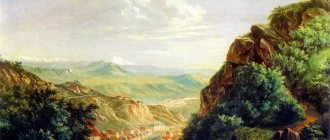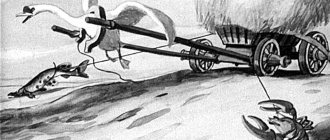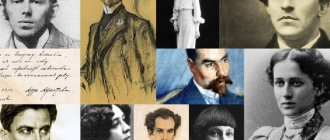Landscape in literature performs an important function. With its help, the author embodies his vision of the world. A description of nature is an expressive element of a literary text that allows the reader to immerse themselves in the atmosphere of a story, short story, novel or poetic work. But, like other artistic images, this component in world literature has gone through a complex and long path of development.
The birth of landscape
Landscape in literature, music, painting is a description of an urban or rural landscape, a mountain slope or virgin forest, in a word, everything that surrounds a person. But if in painting it is a separate genre and originated in ancient times, then in other types of art its history began much later. An important tool for creating ideological and aesthetic content is the landscape. In literature and music, it has long been the subject of study by many art historians and critics. Nature in the works of great composers receives a new beautiful sound. But nowhere else does its description have such a varied and sometimes unexpected purpose as in prose and poetry.
Before the 18th century, landscape almost did not exist in literature. In the works of Antiquity and the Middle Ages, little attention was paid to him. Rather, it served to indicate the location of the action. Humanistic ideas that arose during the Renaissance gave rise to the need to use artistic forms and means with which to reflect the moods and feelings of a person.
Functions of landscape descriptions in a work of art
The purpose of the stated article is to determine the functions of landscape descriptions and their role in the general system of images of a work of art. Landscape descriptions in works of art are the subject of many studies. The term “landscape” is one of the rather frequently used and ambiguous concepts. Most often, researchers proceed from the understanding of landscape as a drawing depicting nature, as well as a description of nature in a work of art.
In our article, we adhere to the definition of landscape presented in the linguistic encyclopedic dictionary: “landscape is a genre of fine art in which the main subject of the image is pristine nature, or nature transformed to one degree or another by man” [3, p. 512].
As one of the components of the artistic image, landscape has come a long way in development. Over time, its content and functions changed depending on literary trends and the individual styles of a particular writer. Until the 18th century, the concept of landscape as an objectively real image of reality did not exist. The discovery of the landscape is associated with an understanding of the new role of man, inextricably linked with nature. According to N. A. Baeva, “until the time when the landscape in the book was assigned only a small decorative role - to inform readers when and where events take place, in what world we are, so to speak, there was not much concern about describing living nature - then they burdened the author.” [1, p. 595].
With the development of literature, writers began to pay more attention to pictures of nature, and gradually the landscape became an integral part of works of art. As G.N. Tolova notes: “the landscape unit almost always occupies a strong textual position in the work of an individual writer” [5, p. 12].
While in painting the landscape in some cases has independent significance as a complete work of art, in literature the landscape is usually included in the general system of images of the work [5].
Reflecting the various stages and aspects of man’s spiritual exploration of the world around him, landscape art carries a great ideological meaning. The beauty of nature exists regardless of a person’s desire, but it influences his consciousness in every possible way and reminds him of the eternal.
Writers learned to see, hear and understand nature better, and to express their feelings, thoughts and moods through landscape descriptions. In comparison with nature, the writer could emphasize the characters’ characters and reflect their thoughts and actions. Landscape began to be considered not only as a means of expressing certain content associated with the description of nature, but also as a way of constructing a text, forming its themes and ideas, as a text unit that realizes the structural and content integrity of an artistic text [6].
Depending on the functions performed in the work, the landscape can have various forms of manifestation: landscape descriptions, landscape images, landscape previews, landscape strokes, landscape details, psychological and epic landscape parallels. In connection with this issue, there is a need to distinguish the landscape itself from the features, elements, and motives of landscape painting. N. Muradalieva proposes to distinguish between two elements in a work of art: a landscape detail and a landscape painting [4].
A landscape detail is a figurative detail that contains information, emotional content, aesthetic assessment and the position of the author. Landscape detail in a work of art appears, as a rule, in the form of various tropes. This is not the subject of the image, but a means of depicting the subject. The landscape detail plays a service role in the context: metaphorical imagery is based on the landscape detail, recreating the appearance of the hero of the work of art. A landscape painting (the landscape itself) is itself the subject of description and reconstruction of the surrounding nature [4].
A unified classification of landscapes, both by linguists and literary scholars, has not yet been developed, since the linguistic study of landscape descriptions presupposes the possibility of various approaches to the phenomenon being studied.
G.N. Tolova in her study proposes to separate landscape descriptions based on their location in the composition of a work of art. They can be: initial; intertextual; final [5].
Taking into account the volume and local location of the landscape in the text, researchers identify the following types:
a) outline or line (based on a short image to which the author refers once);
b) dispersive-stroke (consists of several short details-strokes that name a specific feature);
c) compact-descriptive (represented by one voluminous dicteme);
d) dispersive-descriptive (a series of detailed landscape descriptions scattered throughout the narrative).
These types of verbal landscape can be considered as units of context-variable division of the text [2].
There is a classification of landscapes according to geographical and temporal characteristics. Based on these characteristics, the following types of landscape descriptions are distinguished:
‒ landscapes of the annual and daily natural cycle (descriptions of nature at any time of the day or season);
- geographical landscapes (mountains, forests, seas, rivers, deserts);
- landscapes of vertical and horizontal space (sky, sun, moon, ravine, plain, meadow);
- calm and stormy landscapes (calm sea, storm, storm, hurricane);
- natural and artificial landscapes (a familiar, earthly landscape; a landscape created by human imagination) [6].
We also note that the landscape is one of the means of plot and compositional construction of the work. Based on this situation, researchers distinguish between static and dynamic landscape descriptions. A static description is not included in the temporal development of the action; a dynamic description, on the contrary, is included in the event (most often the landscape is given through the prism of the hero’s perception as he moves) [1].
The landscape is constantly found in works of different styles, which, moreover, the features of the landscape, determined by the specifics of the style, acquire its functional originality in each given case.
It is an undeniable fact that landscape description plays an important role in a work of art. Almost any landscape carries emotional and evaluative content and serves to vividly characterize the environment in which the action develops. Also, a landscape description is one of the main means of revealing the character of the heroes of a work; it is indispensable for a subtle analysis of the psychological state of their soul. In addition, pictures of nature can serve to express any thoughts of the author, his feelings and experiences, to convey his attitude to what is happening. The meaning invested in descriptions of nature, their relationship with other components of a work of art depends on the author’s position, which determines the choice of linguistic means used to depict nature and include the landscape in the text system [5].
A landscape in a work of art can perform a variety of functions:
1) modeling or coordinating function;
2) creating local color, depicting the characteristic features of the area in which the events take place;
3) the signaling function indicates a transition from one compositional speech form to another;
4) the function of returning to the natural principle, the moral support, in which the landscape acts as one of the conditions determining the life and way of life of a person. In this sense, nature and man appear inseparable and are perceived as a single whole;
5) the symbolic function turns the landscape description into a symbol of the object of the description;
6) the aesthetically adjusting function attracts the reader’s attention to the information being communicated; nature in works is often poetic and beautiful [1].
Depending on the aesthetic function, the landscape can be:
- epic;
- lyrical-psychological;
- historical;
- philosophical [6].
In accordance with these functions, we can talk about a background landscape, an emotional landscape and a psychological landscape.
When creating pictures of nature, writers relate them to human interests and aspirations. Descriptions of nature allow the author to move, as if on a bridge, from topic to topic, decorate the narrative, give scope to the artist’s imagination, and emphasize the beauty of the author’s speech.
Landscape description is one of the most important components of a work of art, used to realize its structural and content value and create a unique system of images in it. Depending on its functional purpose, a landscape can be presented in an artistic text in the form of strokes and details, in the form of landscape images and psychological parallels.
Thus, we can say that there are a number of classifications of landscape descriptions, based on different approaches to the study of landscape in a work of art. Classification of landscapes according to geographical and temporal characteristics is the most common. In a work of art, the landscape performs many functions, primarily aesthetic, attracting the reader’s attention to the information being communicated. In addition, such functions of landscape descriptions as modeling, symbolic, signaling and the function of revealing the character of the hero through a description of nature are very important.
Further scientific interest is for us to consider the semantic characteristics and functions of landscape descriptions in English-language and French-language works.
Literature:
1 Baeva, N. A. Intertextual essence of landscape descriptions in a literary text: [based on the material of English prose]. Kemerovo: Intellect, 2006. - pp. 594–600.
2 Gosteva, T. F. Linguistic features and text-forming potential of landscape descriptions in American prose of the 19th—21st centuries: dis. Ph.D. Philol. Sci. Barnaul, 2007. - 237 p.
3 Linguistic encyclopedic dictionary / ch. ed. V. N. Yartseva. M.: Sov. encyclopedia, 1990. - 685 p.
4 Muradalieva, N. Romantic landscape in literature. Baku: Yazichy, 1991.- 204 p.
5 Tolova, G. N. Landscape in literature and art. Perm: Publishing house PGPI, 1993. - 52 p.
6 Epstein, M. N. The system of landscape images in Russian poetry. M.: Higher. school, 1990. - 304 p.
Functions
Landscape plays a huge role in prose and poetry. In literature, music, painting, this concept is not equivalent. In fine art, landscape is a genre in which the main subject is pristine or man-made nature. In music, it is the reflection of environmental sounds using musical instruments. The role of landscape in literature is great because it can carry not only a background, but also a semantic load. In a work of art, depending on the author's intentions, a landscape description can indicate the location of the action, create a certain atmosphere, or reveal the character of the hero.
Thus, landscape in literature and painting is a powerful means of depiction. As Leonardo da Vinci said, the beauty of nature in fine art cannot be heard, it can only be contemplated. Poetry and music make it accessible to the ear.
The role of landscape sketches in the story by I.S. Turgenev "First Love"
Nature and man are quite closely related to each other.
In works of art, writers use descriptions of nature and its influence on characters in order to more deeply reveal their souls, characters, and actions. I.S. Turgenev is known to readers as a great master of landscape. And although there are not too many landscape sketches in the story “First Love”, they are all very expressive, varied and not random in the text. Each landscape in the work plays a specific role. For example, a picture of the so-called “sparrow night”, when a thunderstorm passes somewhere far away. The same new feeling, similar to the flash of lightning, first flares up in the soul of the main character Vladimir when he returns from the Zasekins’ house, enchanted by Zinaida. Having read the description of this night thunderstorm, we seem to imagine what is happening in the soul of a sixteen-year-old boy: “Dim, long, like branched lightning continuously flashed in the sky. These silent lightnings, these restrained sparkles, seemed to answer those silent and secret impulses that also flared up in me. The morning began to get busy; The dawn appeared in scarlet spots. As the sun approached, the lightning grew pale and shortened... And my lightning disappeared within me. I felt great fatigue and silence... but the image of Zinaida continued to float around, triumphing over my soul.” How accurately, through this description of nature, the author recreates that new feeling that captured the main character. Volodya, in love, can no longer think about anything or work. He, “like a beetle tied by the leg,” circles around the house where Zinaida lives, or sits for hours on high stone ruins and looks, not seeing anything around. But in fact, the landscape around him, although everyday, is very lively: “White butterflies fluttered lazily across the dusty nettles, a lively sparrow sat nearby and chirped irritably, turning with its whole body and spreading its tail, incredulous crows occasionally croaked, sitting high on the naked top of a birch tree ; the sun and wind played quietly in its liquid branches; The ringing of the bells of the Donskoy Monastery flew in from time to time...” And we understand Volodya, his romantic nature, we see the depth and strength of his feelings. Everything that happens in nature resonates in his soul: “I sat, looked, listened and was filled with some kind of nameless feeling, which contained everything: sadness, and joy, and a premonition of the future, and desire, and fear of life... " The complete opposite of Zinaida’s state is the landscape surrounding her in the garden. “It was very difficult for her, she went into the garden and fell to the ground as if she had been knocked down.” And “it was light and green all around; the wind rustled in the leaves of the trees. Somewhere pigeons were cooing and bees were buzzing. The sky was softly blue from above...” Beautiful and bright nature is here as a means to show how bad and difficult it is for Zinaida at this time. When Volodya, in a state of strong excitement and fear, watches Zinaida’s house at night, all of nature seems to help us understand the feelings that he experiences: “The night was dark, the trees were whispering slightly, a quiet chill was falling from the sky. But a stripe of fire flashed across the sky: the star rolled. And suddenly everything became a deeply silent circle, as often happens in the middle of the night...Even the grasshoppers stopped chattering.” All the surrounding nature also experiences a strange excitement and tension and, as if, involuntarily influences the young man. The author very accurately describes Volodya’s state when he learns the truth about his father’s attitude towards Zinaida: “What I found out was beyond my power... It was all over. All my flowers were torn out at once and lay around me, scattered and trampled.” This small fragment of the landscape showed the hero’s spiritual tragedy so well that it is difficult to find more suitable words. All the author’s landscape sketches, in my opinion, are very bright, talented, once again show the extraordinary beauty of nature and reveal the broad soul of the Russian people. Source
Russian literature
Perhaps there is no work in Russian literature in which there is no landscape. The classics used this extra-plot element for various purposes. One of the best landscape writers of world importance is Ivan Turgenev. Using a description of nature, this author showed how the protagonist’s mood changes. He achieved this with the help of very dynamic landscapes: “A strong wind suddenly began to roar in the heights. The rain poured down in streams."
Landscape in literature is also used to convey national flavor, which can be seen in the romantic works of Nikolai Gogol. Depending on the direction, the functions of landscape descriptions may change. Thus, for the same author, in realistic prose, the image of the surrounding world serves to reveal the internal anxieties and experiences of the hero. And in the accusatory and satirical story “The Overcoat,” the cold St. Petersburg landscape perhaps serves as a symbol of the cruel bureaucratic world.
Landscape in literature. His role in the work
Landscape in literature (from the French pays - area, country) is a natural sketch or description of any open space of the outside world in a work of art.
The functions of landscape in the text are different and are determined by the genre, style, compositional features and semantic orientation of the work. It can have an independent meaning (for example, in lyrics) or contribute to the expression of the emotions and moods of the hero, be part of the depicted picture, setting, or explain the essence of the events taking place (as in A. Pushkin’s novel “Eugene Onegin”). Sometimes the landscape becomes a form and means of embodying the author’s worldview (for example, in M. Prishvin’s work “Behind the Magic Kolobok”, stories and fairy tales by K. Paustovsky).
The nature of landscape has changed in the history of literature. In folklore texts, nature was personified and acted on an equal basis with the characters. In early ancient and medieval works, the landscape was depicted as the background of the action. And in the literature of the 18th - 20th centuries. it began to have emotional and psychological significance, starting with the texts of sentimentalists (J.-J. Rousseau, N. Karamzin, etc.), as a means of understanding the inner life of a person. In romantic works, the landscape served as a form of expression for the freedom-loving impulses and aspirations of the individual (these are the landscapes of J. Byron, A. Pushkin, M. Lermontov): nature in them is not depicted peacefully, like the classicists in the pastoral genre or the sentimentalists, it is stormy, powerful, restless and exotically colorful, to match a romantic hero. In the literature of realism, landscape conveys the essence of the relationship between man and the world, between man and society, and acts as one of the ways of socio-psychological characterization of a character. A new type of landscape also appears in realistic texts - urban, i.e. urban. We can find examples of it in the works of N. Gogol (“Petersburg Tales”, “Dead Souls”), in the lyrics of N. Nekrasov, in the novels of F. Dostoevsky “Crime and Punishment”, “The Brothers Karamazov”, etc. Finally, in literature modernism, the landscape is part of a chaotic, absurd world (in the novels of A. Camus), or the only harmonious form of world order, opposing the sphere of human relations (in the works of V. Nabokov “Other Shores”, “Spring in Fialta”, etc.).
As an element of artistic space, the landscape participates in creating the image of a chronotope. Thus, in Chekhov’s stories, descriptions of small towns with gray fences, the smell of fried onions or patchouli form the chronotope of the province (“Ionych”, “The Lady with the Dog”).
Source: Student's Handbook: grades 5-11. - M.: AST-PRESS, 2000
More details:
The literary landscape as such appears in the literature of the 18th century, inspired by the great discoveries in the field of natural sciences and the accompanying natural philosophical research of the Enlightenment. What distinguishes landscape in literature from elementary descriptions of nature is not only its aesthetic self-sufficiency, but also its relative artistic independence.
Landscape, be it a landscape poem or landscape scenes in a novel, is by no means an end in itself; it is certainly correlated with a person, even if the latter is not the subject of a direct image. Speaking about the romantic landscape, for example, about Zhukovsky’s elegies, G. Gukovsky preferred the term “landscape of the soul.” We see approximately the same picture of the complete merging of a pantheistically minded subject with nature in the lyrics of B. Pasternak. A realistic landscape in literature, on the contrary, is extremely objective, but its multidimensional connections with a person are obvious: it can correspond or contradict the mood of the character, the author-narrator, the lyrical hero, inspire him with certain feelings and thoughts, and, finally, be a direct or indirect accomplice in the action .
Images of the natural world, not necessarily in the form of a landscape, often occupy commanding heights in a work, performing, say, the role of the title symbol (“Thunderstorm”, “Forest” by A.N. Ostrovsky, “The Cherry Orchard”, “Steppe”, “In the Ravine” A. Chekhov, “The Nightingale Garden” by A. Blok).
Being the center of the poetic universe, first of all, as the main object of the image, a character in the exterior and interior of the reality surrounding him, a person at the same time constitutes its other center as a creative subject, marking the sphere of author’s consciousness in the content of a literary work. Source: Fedotov O.I. Fundamentals of literary theory: Textbook. aid for students higher textbook establishments: At 2 o'clock - M.: Humanit. ed. VLADOS center, 2003. - Part 1
Cityscape
Everything that surrounds a person has changed rapidly over the last century. Life is mainly concentrated in large settlements and cities. And that is why the urban landscape has become widespread in literature. The novel “The Master and Margarita” begins with a description of one of the historical places in Moscow. But Mikhail Bulgakov uses it not only to indicate the meeting place of the main characters and the beginning of the plot. The author draws “A Terrible May Evening” with the aim of creating a certain mysterious atmosphere, foreshadowing a significant terrible event. As a result, the reader, from the very first lines, experiences a sense of impending danger that threatens the characters in the novel.
In the chapter in which Bulgakov depicts the fateful meeting of the Master and Margarita, very little is given to the description of the city landscape. But the mention that the heroine turned from Tverskaya Street into an alley, and in her hands were yellow flowers, which are the first to appear in Moscow, creates a picture of an early gray urban spring. This picture is dull and sad, but it is not devoid of romance and hope.
Village landscape
In the foreground in Alexander Solzhenitsyn’s story “Matrenin’s Dvor” there is a description of the extraordinary character of the main character. But the difficult fate of a peasant woman cannot be conveyed in a text without such a visual means as a rural landscape in literature. A photo of a poor neglected hut can be seen below. It was here that the writer spent almost a year and met the woman who served as the prototype for the main character of the story. The image of the hut, along with the image of the Russian village, creates a background, without which a complete picture of the desolation of peasant life is impossible.
Landscape in a fairy tale
The description of landscape in literature is a visual means that is often present in fairy tales. A mysterious dense forest, a fabulous mountain or a magical stream appear before the reader’s eyes with wondrous images. Without these paintings, the work would not have bright magical shades. But many literary scholars believe that in the fairy-tale genre, landscape descriptions are poorly represented and do not perform any significant functions. However, it is enough to recall the works of the romantic Wilhelm Hauff. The adventures of the heroes of the fairy tale “Frozen” begin in the picturesque Black Forest. The German author's narrative begins with an image of a night forest.
The fabulous landscape also adorns the works of the Russian writer Pavel Bazhov. But still, in this genre, the description of nature has an exclusively decorative purpose.
Poetry
Above all, Sergei Yesenin loved Russia, and therefore he attached great importance to the description of the Russian landscape. Nature in the work of this classic is a single organism. Natural phenomena in his works are not only interconnected (“The bird cherry tree is pouring snow”), but also humanized (“Winter sings, calls…”). And in later poems they are literally woven into the hero’s emotional experiences.
Themes of love, creativity and nature are woven together in the works of Boris Pasternak. An example is the poem “February, take out ink and cry,” where the description of early spring is connected with the hope of renewal of life, of changing it for the better. This work contains both the memories of the lyrical hero and his dreams. And everything is accompanied by a description of the world around us, in the smallest detail.
Symbolist prose
What is landscape in literature? It is not easy to define this artistic phenomenon. Many researchers today are trying to generalize this means of expression. Many works are devoted to the role of landscape in the work of individual authors. But the patterns of its use in a literary text have not been identified. Each artist introduces landscape into his work to the extent that it is necessary for the embodiment of his philosophical and aesthetic ideas. In the prose of the beginning of the last century, one encounters descriptions of nature designed to symbolize the experiences, fate, and character of the hero.
Examples of symbolic prose are the short stories of Thomas Mann. In one of them – “Death in Venice” – there are many symbols. The main one is a city engulfed in an epidemic. The main character finds himself in Venice, which, based on its natural characteristics, is associated with romance and death, with joy and mystery. One of the most legendary cities in the work of the German writer serves as the backdrop for a tragic story about a man overcome by passion, and in the name of it deliberately going to certain death.
Landscape as a means of expressing the author’s thoughts is also present in Ivan Bunin’s story “The Gentleman from San Francisco.” Bright pictures from the window do not please the main character, because he has lost the ability to enjoy the beauty of the world around him. The nature of the island of Capri symbolizes everything that the gentleman from San Francisco missed during his long but empty life.
Landscape is an integral part of classical literature. It is impossible to understand the works of great poets and writers without analyzing natural descriptions. It is in them that the deep thoughts and ideas of the authors often lurk.
The role of landscape in I. S. Turgenev’s story Asya
(materials for a literature lesson in high school)
Tale by I.S. Turgenev’s “Asya” is dedicated to love. Love reveals a person most fully. And the description of nature helps to show the inner state of a person.
Descriptions of nature occupy a very large place in the story. They not only attune the reader to subtle empathy, but also accompany every mood, every movement of the soul of his characters.
The story takes place in Germany, on the majestic and beautiful Rhine River. This is no accident. The author specifically placed the characters in this place to create a romantic atmosphere.
In the first chapter we meet the hero of the story NN, suffering from some “insidious widow.” But his suffering is so insincere, so unnatural, that even the hero himself notices it.
“To be honest, the wound in my heart was not very deep...”
On the contrary, the description of the evening town is filled with sincerity and liveliness, which is contrasted with the hero’s false love.
“I loved wandering around the city then; the moon seemed to be looking intently at him from the clear sky; and the city felt this gaze and stood sensitively and peacefully..."
In the second chapter, NN meets Asya. Asya's description is adjacent to the description of the wonderful landscape of the Rhine. This seems to confirm everything that was said about Asa.
“The view was absolutely wonderful. The Rhine lay before us all silver, between green banks; in one place it burned with the crimson gold of sunset.”
NN’s conversation with Asya and Gagin, which lasted the whole evening, is also accompanied by a romantic landscape of the evening, first early, then gradually turning into night.
“The day had long gone out, and the evening, at first all fiery, then clear and scarlet, then pale and vague, quietly melted and turned into night.”
The author emphasizes the constant variability of nature, comparing it with Asya’s character.
“I have never seen a more agile creature. She didn't sit still for a single moment."
Turgenev says that Asya’s changeable character is very close to nature.
Descriptions of mountains, valleys, and powerful river flows help the author show the heroine’s strong, unbridled love.
By the fifth chapter, the hero fell in love with Asya. From that moment on, all his attention switches to Asya, and he no longer notices nature. Therefore, there are no descriptions of nature, even when NN accompanies Gagin to sketch landscapes.
Only by the tenth chapter, when the hero breaks up with Asya, does a description of nature appear again. The hero sails along the “royal” Rhine, but there is no peace in his soul.
“I suddenly felt a secret uneasiness in my heart... I raised my eyes to the sky - but there was no peace in the sky either...”
This comparison foreshadows the sad end of the story.
The role of the landscape in the story is to help us better understand the strength of the characters’ feelings and the state of their souls. So that we understand how complex and incomprehensible people’s feelings are, and we must learn to understand them in order to become happy.
Source






